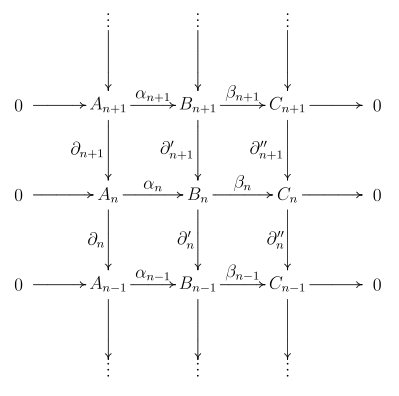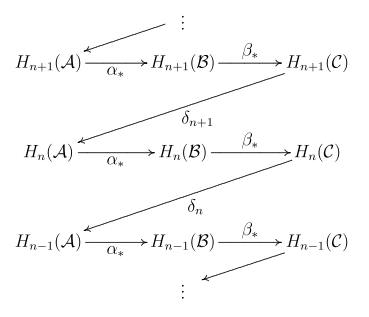Zig-zag lemma
In mathematics, particularly homological algebra, the zig-zag lemma asserts the existence of a particular long exact sequence in the homology groups of certain chain complexes. The result is valid in every abelian category.
Statement
In an abelian category (such as the category of abelian groups or the category of vector spaces over a given field), let  and
and  be chain complexes that fit into the following short exact sequence:
be chain complexes that fit into the following short exact sequence:
Such a sequence is shorthand for the following commutative diagram:

where the rows are exact sequences and each column is a complex.
The zig-zag lemma asserts that there is a collection of boundary maps
that makes the following sequence exact:

The maps  and
and  are the usual maps induced by homology. The boundary maps
are the usual maps induced by homology. The boundary maps  are explained below. The name of the lemma arises from the "zig-zag" behavior of the maps in the sequence. In an unfortunate overlap in terminology, this theorem is also commonly known as the "snake lemma," although there is another result in homological algebra with that name. Interestingly, the "other" snake lemma can be used to prove the zig-zag lemma, in a manner different from what is described below.
are explained below. The name of the lemma arises from the "zig-zag" behavior of the maps in the sequence. In an unfortunate overlap in terminology, this theorem is also commonly known as the "snake lemma," although there is another result in homological algebra with that name. Interestingly, the "other" snake lemma can be used to prove the zig-zag lemma, in a manner different from what is described below.
Construction of the boundary maps
The maps  are defined using a standard diagram chasing argument. Let
are defined using a standard diagram chasing argument. Let  represent a class in
represent a class in  , so
, so  . Exactness of the row implies that
. Exactness of the row implies that  is surjective, so there must be some
is surjective, so there must be some  with
with  . By commutativity of the diagram,
. By commutativity of the diagram,
By exactness,
Thus, since  is injective, there is a unique element
is injective, there is a unique element  such that
such that  . This is a cycle, since
. This is a cycle, since  is injective and
is injective and
since  . That is,
. That is,  . This means
. This means  is a cycle, so it represents a class in
is a cycle, so it represents a class in  . We can now define
. We can now define
With the boundary maps defined, one can show that they are well-defined (that is, independent of the choices of c and b). The proof uses diagram chasing arguments similar to that above. Such arguments are also used to show that the sequence in homology is exact at each group.
See also
References
- Hatcher, Allen (2002). Algebraic Topology. Cambridge University Press. ISBN 0-521-79540-0.
- Lang, Serge (2002), Algebra, Graduate Texts in Mathematics 211 (Revised third ed.), New York: Springer-Verlag, ISBN 978-0-387-95385-4, MR 1878556
- Munkres, James R. (1993). Elements of Algebraic Topology. New York: Westview Press. ISBN 0-201-62728-0.





![\delta _{{}}^{{}}[c]=[a].\,](/2014-wikipedia_en_all_02_2014/I/media/4/c/7/5/4c75e392faa8229822c9b4b2990e9c9f.png)